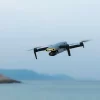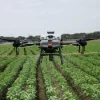The Best Drones For Beginner Pilots
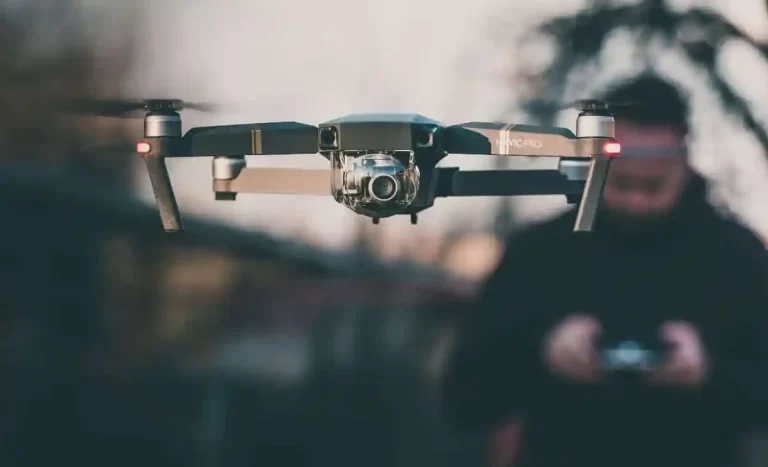
You love the idea of flying the skies and taking beautiful footage of your travels, but you’re worried you won’t be able to manoeuvre a drone properly.
Maybe you’re not tech-savvy or simply afraid of crashing your drone on the first flight.
Well, worry not because today’s drone market is filled with machines for newcomers that are not only extremely easy to fly but also have fantastic quality cameras and won’t break the bank.
The best drone for beginners will be relatively budget-friendly and equipped with some degree of collision sensors because flying these quadcopters is never risk-free, and even the best pilots have accidents.
Many drones nowadays come with built-in safety measures like distance limiters, return-to-home functions, and propeller guards that will help you immensely should you find yourself in a tricky situation. Once you understand how to control your drone and feel more confident flying, you can start to experiment with more exciting shots too.
Whether you want a drone for videography, photography, or even drone racing, some of the best drones available on the market don’t cost as much as you’d think. The quadcopter market has made leaps and bounds in recent years, and there’s a drone for arguably every need.
If you’re looking for the best drones for your kids, there are super-low-cost nano drones, which cost under $50 and are made specifically for younger pilots. Take a look at our guide [add interlink here for the best nano drones article] if you want to know more about the best drones for kids.
One thing to note is that we’ve mainly selected drones weighing under 250g, which is the legal limit in many countries to fly a drone without registering it. Plus, light drones usually mean easier controls, which is a lifesaver if you’re just starting out.
In this list, we’ve selected the best drones for beginners based on various factors, but keep in mind that their design, prices, and characteristics will differ depending on the purpose of the product.
Best Beginner Drone Overall: DJI Mini 2
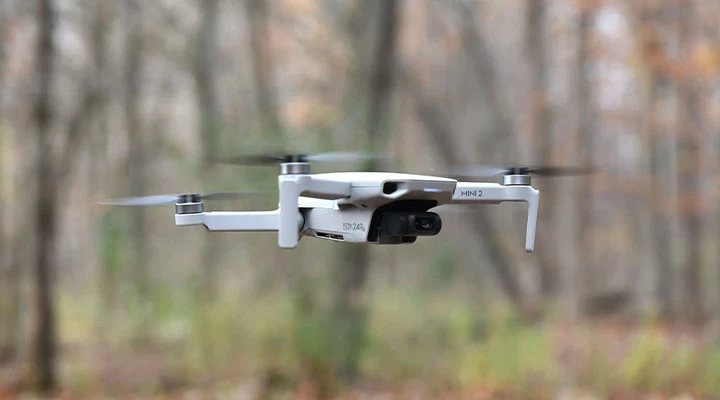
Specifications
| Price | $459 |
| Camera resolution | 12MP 4K |
| Range | 10km |
| Weight | 242g |
| Battery | 30 minutes with a full charge |
| Controller | Included |
| Measures | 13.8×8.1×5.8cm (folded) |
The DJI Mini 2 is an ultra-compact drone that’s so small and easy to use that you can slip it out of a jacket pocket and launch it within seconds.
Because of its affordable price ($459) and specifications, the Mini 2 is one of the best beginner drones for those who want to capture 4K videos and great pictures. The DJI Mini 2’s design is identical to the Mavic Mini, but the controller has been revamped, which is gorgeous, sturdy, and easier to use.
The Mini 2 is foldable with arms that unfold to transform the palm-sized unit into a drone with just a few manoeuvres. The drone weighs less than 250g, so it doesn’t need to be registered with aviation agencies. But check your local laws because some countries may require you to register even sub 250g drones.
The DJI Fly app is also a well-balanced combination of simple to use but with great features for beginners. Newcomers won’t need to venture beyond the main interface, but if you want to, there’s a lot of stuff to master. Mini 2’s stabilization is incredible as it’s rock-steady even in very windy conditions, which is surprising considering how small and dinky the drone is.
The footage you’ll get with this drone is excellent for the price but can look a bit flat and underexposed in overcast scenes. Clarity and crispness are respectable, and the Mini 2 has a 2X zoom if you’re shooting 4K but can be extended to 3X at 1080p. At night the quality of the footage drops considerably, but that’s understandable for a drone at this price point.
DJI’s Mini 2 has a solid battery, with around 30 minutes of flight time on a single charge when shooting a mix of 1080p and 4K. Let’s not forget that if you wanted more battery life, the Fly More combo would give you a combined flight time of 90 minutes (although it costs a few hundred bucks more.)
Pros
- Tiny and compact
- Budget-friendly
- Easy to fly
Cons
- No follow-me mode
- Not the best camera on the market
- Camera is non existent
- Lacks obstacle avoidance sensors
DJI Mini 3 Pro
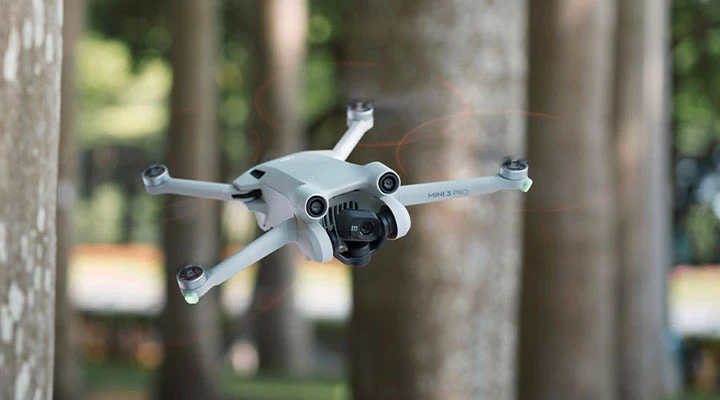
Specifications
| Price | $700 |
| Camera resolution | 12MP |
| Range | 8-12km |
| Weight | 249g |
| Controller | Included |
| Battery | 34 minutes flight time when fully charged |
| Measurements | 14,5x9x6,2 cm (folded) |
This is one of the most expensive models on this list, but the Mini 3 Pro is also the best drone for beginners if the price isn’t an issue.
The tiny and lightweight Mini 3 takes DJI’s popular Mini drone series to new heights. First, it managed to include a tri-directional obstacle avoidance system inside such a small drone, which is a life saviour for newcomers that don’t want to risk their quadcopter’s safety.
Second, the Mini 3’s sensor is bigger, it’s a 1/1.3-inch CMOS with a maximum lens aperture of f/1.7, and it’s also able to capture videos at 4K60FPS, 2.7K60FPS, and FHD120FPS. The camera can also be rotated 90 degrees, enabling you to capture stills and video in both landscape and portrait format.
The list of improvements from the Mini 2 goes on and on, but the crucial factor is that DJI managed to pack such a small drone with incredible specs.
Read our in-depth DJI Mini 3 Pro review here
Pros
- Impressive camera and low-light performance
- Obstacle avoidance sensors
- Useful automated flight modes
Cons
- Expensive
- Good battery but could be better for the price range
Autel Evo Nano+
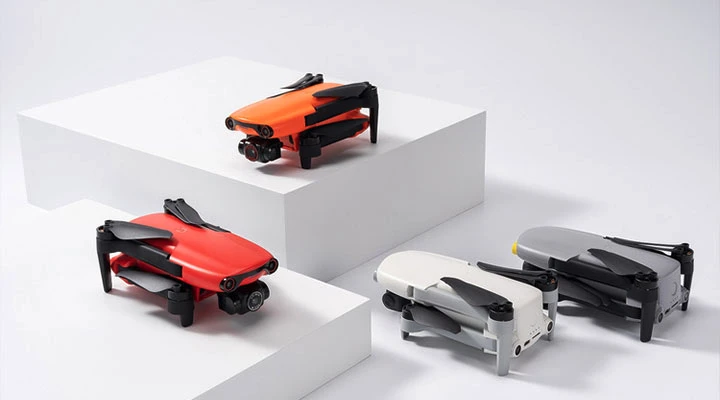
Specifications
| Price | $750 |
| Camera resolution | 12.5MP |
| Range | 16.8km |
| Weight | 249g |
| Controller | Included |
| Battery | 28 minutes with a full charge |
| Measurements | 14,2×9,4×5,5cm |
Autel’s mission was a very hard one, as it’s not easy to get out on top with near-perfect drones like the DJI Mini 2 and 3.
The Autel is an impressive beginner drone in its own right. The Nano+ has a similar camera to the DJI’s quadcopters but captures better footage in low light conditions and has a similar wind resistance.
Autel has spent the last few years trying to convince pilots that good drones are also made by companies other than DJI. The Evo is a sub 249g drone that is physically similar to the Mini 2, with similar folding arm ergonomics to make it highly portable and easy to deploy at any moment.
Compared to the Mini 2, the Nano+ has many features that newcomers will love, such as obstacle avoidance sensors, a great 1/1.28-inch sensor for capturing 4K video and up to 48MP still images, plus an enhanced communication system for long-distance flying. The footage of the Autel is stunning for a drone of this price and weight, and excluding the Mini 3 Pro, the Nano+ is capable of better image and video quality than any other sub-250g drone.
Battery life is a respectable 28 minutes, and for those buying the premium bundle, the total flying time goes up to 84 minutes.
For those beginner pilots who want to be extra safe when flying, the Autel has three-way obstacle avoidance sensors, allowing it to detect structures in the front, behind, and below it while flying. The obstacle avoidance technology is image-based, so it won’t work at night and is disabled when the drone is flying at maximum speed.
Autel’s quadcopter also comes in different colours, such as orange, arctic white, deep space gray, and red.
Pros
- Bi sensor and bright lens
- Collision detection
- Amazing video footage
Cons
- Fragile
- No subject-tracking
- Battery could be better
DJI Avata
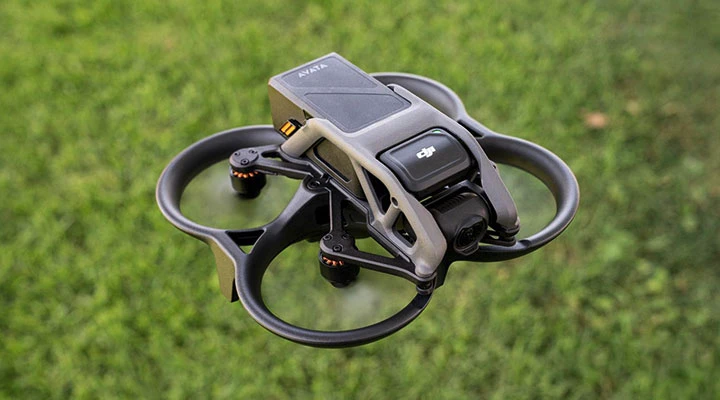
Specifications
| Price | $1100 |
| Camera resolution | 148MP |
| Range | 10km |
| Weight | 410g |
| Controller | Included |
| Battery | 30 minutes with a full charge |
| Measurements | 18x18x8cm |
Although the DJI Avata can be a beginner’s drone, it isn’t as approachable as the more traditional drones on this list. Why? Because it’s an FPV drone that uses a combination of DJI’s Motion Controller and DJI goggles to give you the sensation of flying in a first-person view.
FPV is an incredible experience, as you’ll feel like you’re a bird flying through the clouds. However, the critical issue is that this type of flying is a significant departure from flying camera drones, and not all pilots will enjoy it. Motion sickness is a real possibility for some pilots flying the Avata, and flying a drone from a first-person perspective is a lot different from a third-person view you may be used to.
This change in perspective makes it much harder to calculate distances, and if you fly the Avata in tight spaces with multiple objects, you’ll likely crash a couple of times. Although the Avata lacks collision sensors, DJI’s quadcopter has plenty of safety features to make it as sturdy as possible.
The Avata has propeller protection to ensure your drone can survive multiple crashes without too many issues, and many pilots can attest to that.
Another issue with the Avata is its weight, at 410g, you’ll need to register the drone before flying. And on top of that, the price is also extremely high ($1000+ for the combo with the goggles) compared to the competition on this list.
You can fly the quadcopter indoors or outdoors while shooting impressive 4K60FPS videos and staggering pictures, but we advise you to always check for other people before flying the Avata. Because of the fact that it’s pretty tricky to calculate distances with this drone, you can easily crash into someone causing some severe damage if you’re not careful enough.
So we recommend the DJI Avata only to those who have a bigger budget and want a unique experience with the first-person view mode.
Read our in-depth DJI Avata review here
Pros
- Crash resistant design
- FPV view is amazing
- Large sensor for mind-blowing footage
Cons
- Expensive
- No collision sensors
- Hard to manoeuvre
Ryze Tello
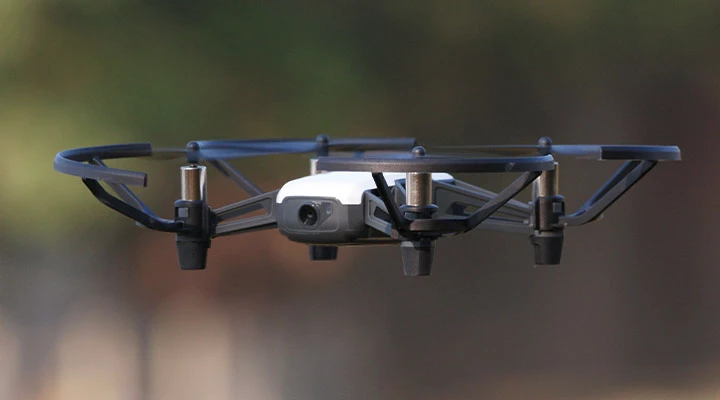
Specifications
| Price | $100 |
| Camera resolution | 5MP |
| Range | 100m |
| Weight | 80g |
| Controller | Not included |
| Battery | 13 minutes when fully charged |
| Measurements | 9,8×9,2×4,1cm |
The Ryze Tello is the result of a collaboration between leading consumer drone maker DJI and a Chinese start-up called Ryze.
It’s an ultra-lightweight and affordable quadcopter clearly pitched at newcomers to the hobby. Despite its budget-friendly price, it comes with an onboard nose-mounted camera capable of capturing 5MP photos and taking 720p HD video.
Flight time is also decent considering weight and price, at a good 13 minutes with a fully charged battery. The Tello also has stability sensors that should theoretically keep it from drifting off into walls and obstacles.
In short, the Ryze Tello has been stripped right back to the bone to keep the costs as low as possible, however, that doesn’t mean the Tello is completely cheap. Even the plastic body of the drone feels tough enough to survive a bit of rough.
The Tello is an affordable, compact, and lightweight drone that’s ideal for mastering the basics. It’s controllable via your smartphone only, as it doesn’t include a remote, but you could also use a Bluetooth gaming controller to fly it. The quadcopter is pretty responsive and easy to fly.
It’s not all positive, though. The flight range is very limited ( Ryze says 100m, but it’s way below that), and the slightest breeze will send the Tello flying away.
Pros
- Responsive controls
- Tiny and lightweight
- Decent battery
- Very cheap
Cons
- Doesn’t fly well in the wind
- No controller included
- Very flimsy
FIMI X8 Mini
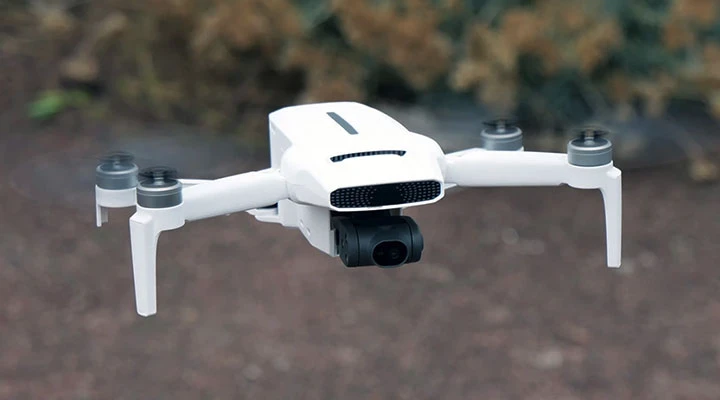
Specifications
| Price | $350 |
| Camera resolution | 12MP |
| Range | 8km |
| Weight | 250g |
| Battery | 30 minutes when fully charged |
| Measurements | 14,5×5,6×8,5cm (folded) |
Drones of any size will always be measured up against the best that DJI has to offer, as DJI is the market’s leader when it comes to quadcopters.
But, if DJI didn’t exist, Fimi’s X8 could be the perfect entry-level 4K drone. It’s slightly cheaper than the Mini 2, yet offers many features that make its flying rival a winner. Let’s not forget that the X8 is also light enough to fall into the sub-250 g category, avoiding the registration process.
The Fimi X8 is an entry-level drone with some serious capabilities. While it’s relatively affordable, beautifully compact, and lightweight, it’s no child’s plaything regarding specs. The camera supports 4K video, and the battery supports 30 minutes of flight over a range of up to 8km.
With a simple but effective app and a well-designed remote controller, Fimi has created an excellent drone. The X8 can be flown in windy conditions, but the footage will be sharp and stable.
The fact that the X8 is foldable means that you can easily toss it in your backpack every time you head out for the day or go on a trip. It can also be charged from any USB-C port.
For around $350, it’s a fantastic deal, but because the Mini 2 exists, we’re not sure the X8 is the best bang for your buck. The X8 indeed has excellent specs and costs less than the Mini 2, however, we still think the Mini 2 is a better deal even at its slightly higher asking price.
Pros
- Slightly cheaper than DJI’s rivals
- Easy to fly
- Under 250g
- Good battery life
Cons
- No font-facing collision sensors
- Worse than DJI’s competition overall
Parrot Anafi
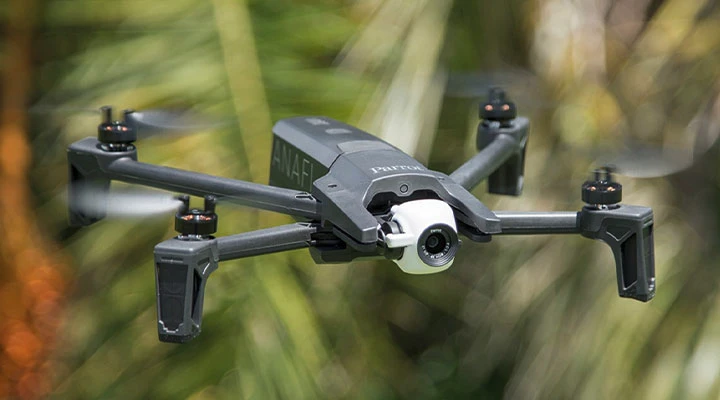
Specifications
| Price | $380 |
| Camera resolution | 21MP |
| Range | 4km |
| Weight | 320g |
| Battery | 25 minutes with a full charge |
| Measurements | 24,4×6,7×6,5cm (folded) |
| Measurements | 24,4×6,7×6,5cm (folded) |
With the Parrot Anafi, you get a drone that’s easy enough for beginners but also offers the features and functionality you’ll naturally desire as your skills and confidence grow. So, while not the cheapest drone on the market for beginners, it’s undoubtedly one of the several models that could provide excellent longevity.
The Anafi is small and lightweight, but at a weight of 320g, it requires registration. Like most high-quality drones, the Anafi features automated flight patterns to make capturing professional-looking photos and videos easy without knowing how to perform complicated manual flying manoeuvres.
The main problem with the Anafi is the lack of collision-avoiding systems, so you’ll have to be careful when flying it. Yet, flying the Anafi is a delight. With the Sky Controller 3 and the intuitive app, you’ll have a bunch of helpful tutorials to help you out if you’ve never flown a drone.
It also features a Return To Home button in the centre of the controller, which is always a great addition, especially for newcomers who may have issues landing the drone.
The camera is capable of shooting high-quality photos and videos thanks to the 21MP sensor and the ability to shoot video at up to 4K. There’s also a digital zoom of up to 2.8X and a standard zoom of 3X. Video settings are more limited compared to DJI’s quadcopters, but you get all the important ones with the Anafi.
The Anafi gives with one hand and takes with the other. It can capture great 4K videos and detailed photos but has no obstacle avoidance either.
Pros
- Small, lightweight, and foldable
- 21MP camera and 4K videos
- Easy to fly
Cons
- More expensive than the most basic models
- No collision avoidance systems
How To Pick The Best Beginner Drone For You
Beginner drones come in various shapes, sizes, and prices, but the best ones all share a few key features. If you’re just starting out, then a good and easy-to-use companion app will be invaluable, and one of the best is DJI’s Fly app. A quadcopter with good stability and hover technology will also allow you to carefully learn the controls and assess how sensitive it is to control.
If you’re looking for a beginner drone with a great camera, keep in mind that you’ll have to spend a bit more as the majority of the cost of a drone usually goes into it. Generally, look for a camera with at least a 1080p30FPS mode, as lower resolutions, such as 720p, will give you mediocre footage.
Also, think about where you will most likely fly your drone. If you’re happy to stay indoors, then a small toy model like the Ryze Tello will be more than enough. But for more ambitious flights, you’ll need a drone that can both withstand wind and a few crash landings, like the Mini 2 or Mini 3.
Final Words
Many drones aimed at beginners are basic models in terms of camera functionality and overall features. But they will have the same basic controls as larger and more expensive models, so you can feel how they work without the fear of wasting a ton of money if you crash them.
Even if you’re on a lower budget, getting a sub $250 drone is not a bad idea just to learn the basics and then move to something bigger and more expensive. Once you feel confident with the controls, you’ll know it’s time to move up and upgrade to the next level.
Two are the things you have to consider as a beginner. First is the weight because drones weighing less than 250g will require no registration. The registration process is easy and inexpensive but can still be a hassle sometimes. Second, you need to look for safety measures like obstacle detection systems.
Unfortunately, not many budget drones offer good anti-collision systems, but some in this list have basic collision detection systems. You can get by without this safety feature as a beginner, however, we do recommend getting a quadcopter with some safety sensors in place.
Whatever drone you decide to buy, get ready to see the world in a completely different, new, and exciting way.

